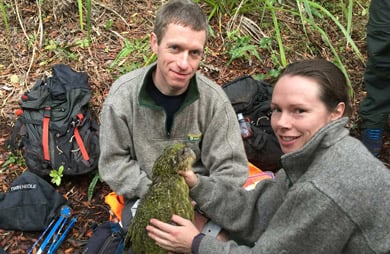
Introduction
The kākāpō is a nocturnal, flightless parrot. And its strangeness doesn't end there. It's critically endangered and one of New Zealand’s unique treasures.
Andrew Digby and Deidre Vercoe health-check a kākāpō chick
Image: Lou Sanson | DOC
There are fewer than 250 kākāpō alive today.
New Zealand status: Endemic
Conservation status: Threatened – Nationally Critical
Found in: Codfish Island/Whenua Hou, Anchor Island and Te Hauturu-o-Toi/Little Barrier Island
Threats: Predators, disease, genetic inbreeding, infertility
Sound recordings:
Kākāpō male 'booms' (MP3, 2,102K)
02:14 – Adult male 'booming' to attract females.
Kākāpō male 'chings' (MP3, 345K)
00:22 – Adult male 'chinging' to attract females.
Kākāpō male territorial calls (MP3, 2,361K)
02:30 – Adult male giving territorial calls (00:43). Screaming in answer to playback of booming call played through amplifier.
Kākāpō female song (MP3, 1,396K)
01:28 – Adult female.
Species information: Kākāpō on NZ Birds Online
Kākāpō conservation
Have you met our Spokesbird?
Sirocco is New Zealand's official Spokesbird for conservation.
Kākāpō Recovery leads kākāpō conservation efforts today. They face major challenges due to kākāpō infertility and inbreeding. Nevertheless, they've had some triumphant successes using innovative techniques to grow the population.
The history of kākāpō is a story of drama, despair and hope. Before humans arrived, kākāpō were abundant throughout New Zealand. Population numbers dropped swiftly due to hunting, introduced predators and land clearance. Conservation efforts began in 1894, but by the mid-1900s, kākāpō teetered on the edge of extinction.
What's unusual about kākāpō?
The kākāpō is a large green parrot with a distinctive owl-like face and a waddling gait. They cannot fly, but they climb well.
Kākāpō are:
- nocturnal
- flightless
- the only lek-breeding parrot species in the world
- perhaps the longest-lived bird species in the world, estimated to reach 90 years
- the heaviest parrot species in the world – smaller females weigh 1.4 kg, and males 2.2 kg. And they can pile on 1 kg of fat prior to a breeding season.
Meet some of the stars of the kākāpō population.
Kākāpō are solo hikers with big voices and a tendency to freeze when threatened.
Find out where kākāpō used to live, and where they live today.
Keep an eye out for kākāpō sign when you’re in remote areas of New Zealand.



